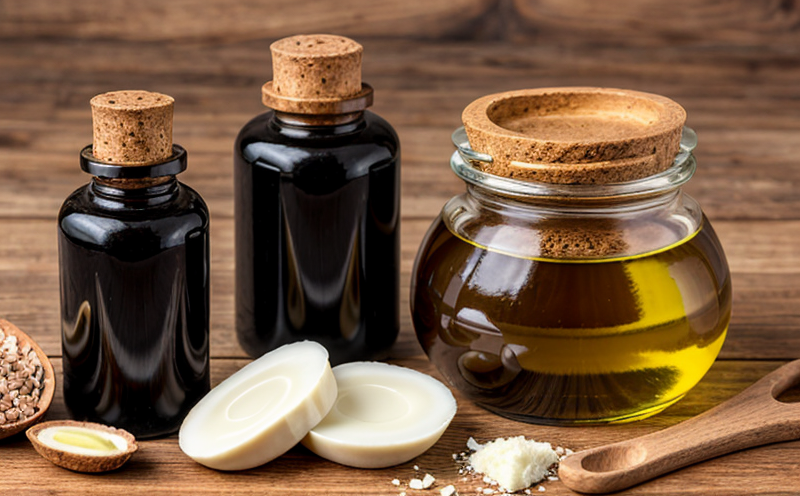ISO 6885 Oxidative Stability Testing in Fats
The ISO 6885 standard defines a method to assess the oxidative stability of fats and oils, which is critical for ensuring product quality and safety. This test evaluates how effectively antioxidants protect against oxidation, thereby determining the shelf life and stability of food and feed products.
Understanding the process begins with recognizing that fat oxidation leads to rancidity, which can compromise both the taste and nutritional value of fats used in processed foods. The ISO 6885 method is designed to measure how well antioxidants prevent this degradation by observing the rate at which peroxides form during heating.
The test involves subjecting a sample of fat or oil to high temperatures, typically between 100°C and 120°C, in an oxygenated environment. The sample is then monitored for the production of peroxides over time. This process simulates real-world conditions under which fats are exposed to heat during processing or storage.
The test is particularly relevant for industries where extended shelf life is crucial, such as snack foods, shortenings, and margarines. By measuring oxidative stability, manufacturers can optimize the use of antioxidants and ensure their products meet regulatory standards. This method also helps in understanding how different processing conditions might affect product quality.
The ISO 6885 procedure requires precise control over temperature, oxygen concentration, and sample preparation to yield accurate results. The standard specifies that samples should be prepared as closely as possible to the form they will encounter in commercial use. This includes considering factors such as packaging, storage conditions, and any processing steps involved.
The test apparatus used for ISO 6885 typically consists of a closed system where the sample is heated while oxygen is continuously supplied. The peroxide value is measured using specific reagents that react with peroxides to produce a detectable signal. This measurement provides an indication of the extent of oxidation and thus helps in assessing the effectiveness of antioxidants.
Compliance with ISO 6885 ensures that products meet quality standards, which is essential for maintaining consumer trust. By using this method, companies can ensure their products are safe, stable, and comply with international regulations. This is particularly important in a global market where food safety and regulatory compliance are paramount.
The process of oxidative stability testing under ISO 6885 involves several key steps. First, the sample must be prepared according to the standard’s specifications. This may involve homogenizing the fat or oil to ensure consistent results. Next, the sample is placed in a closed system where it is heated and exposed to oxygen. During this process, peroxides are continuously formed due to oxidation.
The formation of peroxides can be monitored by taking periodic samples from the system for analysis. Typically, measurements are taken every few minutes or hours depending on the rate of peroxide production. The results of these analyses provide a quantitative measure of oxidative stability. This data is then used to calculate the peroxide value (POV), which indicates the extent of oxidation.
Understanding the real-world implications of ISO 6885 testing helps in optimizing product formulations and processing methods. For instance, if the results indicate high levels of peroxides, it may be necessary to adjust antioxidant levels or alter packaging materials to provide better protection against oxygen. This ensures that products remain safe and have an extended shelf life.
The method also plays a crucial role in research and development by providing insights into how different factors affect oxidative stability. For example, researchers can study the impact of different antioxidants, processing temperatures, or storage conditions on product quality. This information is invaluable for developing new formulations that meet both regulatory requirements and consumer expectations.
Benefits
- Ensures compliance with international standards for food and feed safety
- Promotes the development of products with extended shelf life
- Enhances product quality by optimizing antioxidant usage
- Safeguards against potential health risks associated with rancid fats
International Acceptance and Recognition
- The ISO 6885 method is widely recognized in the global food industry as a reliable measure of oxidative stability.
- Countries around the world use this standard to ensure that their products meet international quality standards.
Competitive Advantage and Market Impact
Adopting ISO 6885 testing can provide significant competitive advantages in the market. By demonstrating a commitment to product quality and safety, companies can build trust with consumers and regulatory bodies alike. This can lead to increased sales and better brand reputation.
The method also helps in differentiating products within a crowded market by highlighting superior quality through rigorous testing. For instance, snacks that pass stringent ISO 6885 tests are more likely to be preferred by discerning consumers who value freshness and safety.





